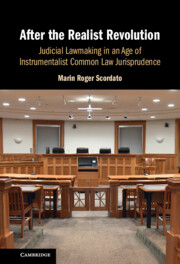Refine search
Actions for selected content:
29 results
Underdetermination and unconceived alternatives in science and theology: some historical perspectives
-
- Journal:
- Religious Studies , First View
- Published online by Cambridge University Press:
- 04 September 2025, pp. 1-11
-
- Article
-
- You have access
- Open access
- HTML
- Export citation
1 - Introduction
-
- Book:
- After the Realist Revolution
- Published online:
- 02 May 2025
- Print publication:
- 22 May 2025, pp 1-3
-
- Chapter
- Export citation
3 - The Realist Critique of the Traditional Understanding and the Paradigm Shift from Formalism to Instrumentalism
-
- Book:
- After the Realist Revolution
- Published online:
- 02 May 2025
- Print publication:
- 22 May 2025, pp 11-20
-
- Chapter
- Export citation

After the Realist Revolution
- Judicial Lawmaking in an Age of Instrumentalist Common Law Jurisprudence
-
- Published online:
- 02 May 2025
- Print publication:
- 22 May 2025
10 - Realism and Antirealism
- from Part II - Ongoing Investigations
-
- Book:
- An Introduction to the Philosophy of Science
- Published online:
- 29 March 2025
- Print publication:
- 27 March 2025, pp 217-264
-
- Chapter
- Export citation
19 - Quantum Mechanics as a Physical Theory
-
- Book:
- The Einstein Paradox
- Published online:
- 14 November 2024
- Print publication:
- 28 November 2024, pp 262-264
-
- Chapter
- Export citation
1 - Oil and Islam in the Gulf
-
- Book:
- Refining the Common Good
- Published online:
- 08 November 2024
- Print publication:
- 21 November 2024, pp 1-29
-
- Chapter
- Export citation
6 - Affirmative Action and Reclassification
-
- Book:
- Back to Black
- Published online:
- 14 November 2024
- Print publication:
- 17 October 2024, pp 171-208
-
- Chapter
- Export citation
Isolationism, instrumentalism and fiscal policy
-
- Journal:
- Economics & Philosophy / Volume 41 / Issue 1 / March 2025
- Published online by Cambridge University Press:
- 27 March 2024, pp. 79-97
-
- Article
-
- You have access
- Open access
- HTML
- Export citation
3 - Early Reform Era (December 1978–1991)
- from Part II - China’s Development Trajectory and the Role(s) of Law
-
- Book:
- Law and Political Economy in China
- Published online:
- 10 August 2023
- Print publication:
- 24 August 2023, pp 37-48
-
- Chapter
- Export citation
1 - Introduction
-
- Book:
- Law as an Instrument
- Published online:
- 07 July 2022
- Print publication:
- 21 July 2022, pp 1-15
-
- Chapter
- Export citation
5 - Christian Just War Thinking and Modernity
-
- Book:
- Modernity, the Environment, and the Christian Just War Tradition
- Published online:
- 05 May 2022
- Print publication:
- 26 May 2022, pp 223-245
-
- Chapter
- Export citation
2 - Economic Logic with Internal Consistency (and Not Only Formal Rigour)
-
-
- Book:
- Pasinetti and the Classical Keynesians
- Published online:
- 17 February 2022
- Print publication:
- 24 February 2022, pp 30-49
-
- Chapter
- Export citation
1 - Introduction: Pedagogy and Conceptualization of the Field
- from I - Introduction to the Field
-
-
- Book:
- Constitutionalism in Context
- Published online:
- 17 February 2022
- Print publication:
- 17 February 2022, pp 3-22
-
- Chapter
- Export citation
3 - Instrumentalism
- from Part I - Clearing the Ground
-
- Book:
- Good Science
- Published online:
- 06 January 2022
- Print publication:
- 20 January 2022, pp 29-38
-
- Chapter
- Export citation
1 - Understanding Sikh Nationalism
-
- Book:
- Sikh Nationalism
- Published online:
- 19 November 2021
- Print publication:
- 25 November 2021, pp 8-30
-
- Chapter
- Export citation
6 - The Fate of Human Rights
-
- Book:
- Ruling by Cheating
- Published online:
- 07 August 2021
- Print publication:
- 12 August 2021, pp 198-236
-
- Chapter
- Export citation
Chapter 7 - Resilience and Mindfulness
-
- Book:
- Beyond Virtue
- Published online:
- 23 October 2020
- Print publication:
- 05 November 2020, pp 132-148
-
- Chapter
- Export citation
Who Will Pay?
- from 16 - Postscript: How to Talk about Chaucer with Your Friends and Colleagues
-
-
- Book:
- The Cambridge Companion to The Canterbury Tales
- Published online:
- 21 August 2020
- Print publication:
- 10 September 2020, pp 250-254
-
- Chapter
- Export citation
6 - Liberal Iconoclasm
- from Part 3 - Politics
-
- Book:
- Kinship, Law and Politics
- Published online:
- 09 June 2020
- Print publication:
- 02 July 2020, pp 112-118
-
- Chapter
- Export citation
